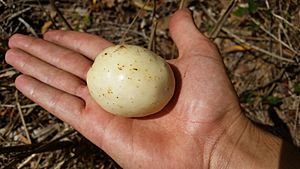October Glory facts for kids
Quick facts for kids October Glory |
|
|---|---|
 |
|
| Faradaya splendida fruit on palm of hand | |
| Scientific classification | |
| Kingdom: | |
| (unranked): | |
| (unranked): | |
| (unranked): | |
| Order: | |
| Family: | |
| Genus: |
Faradaya
|
| Species: |
F. splendida
|
| Binomial name | |
| Faradaya splendida |
|
| Synonyms | |
|
|
Faradaya splendida is a beautiful evergreen vine. It belongs to the Lamiaceae family, which also includes mint. This plant grows lovely white, sweet-smelling flowers. It also produces white, egg-shaped fruits.
You can find F. splendida growing naturally in the warm, wet rainforests of tropical Asia and Australia. It often grows along the edges of these forests, like near roads. People call it by many names, such as October Glory, Glory Vine, Potato Vine, and Fragrant Faradaya. In Australia, Indigenous people have their own names for it. These include Garanggal, Buku, Koie-yan, and Djungeen.
Contents
What it Looks Like
This plant is a woody vine that stays green all year. It can twine around other plants and grow quite thick, up to 15 centimeters wide. Its shiny, dark green leaves are shaped like eggs. They can be as long as 24 centimeters and 13 centimeters wide. The leaves grow in pairs or groups of three. Each leaf has a stem, called a petiole, that can be up to 8 centimeters long.
F. splendida blooms and grows fruit during the warmer months, from August to April. Its white, fragrant flowers are very common but don't last long. Sometimes, they only stay open for one day! Each flower is about 4.5 centimeters across. The fruit is white and soft, with one large seed inside. It looks like a potato or a big egg, about 8 centimeters long and 5 centimeters wide. The seed has a rough, brown coating that is 1 to 3 millimeters thick. Inside, the seed is smooth.
How it Got its Name
The plant was officially described in 1865 by a botanist named Ferdinand von Mueller. He named it based on plants found near Rockingham Bay in Queensland, Australia. This was the first plant to be placed in the Faradaya group. The name Faradaya honors the famous scientist Michael Faraday. The second part of its name, splendida, means "splendid" or "shiny." This refers to the glossy look of its dark green leaves.
Over time, scientists realized that many plants once thought to be different species of Faradaya were actually just F. splendida. For example, some plants were called different names based on where their flowers grew. But later, it was found that the flowers can grow in different places on the plant at different times.
Where it Grows
You can find F. splendida in many places. It grows in Indonesia, Malaysia, Papua New Guinea, the Solomon Islands, and Queensland, Australia. This tough vine can live in different types of forests. These include rainforests, hill forests, and swamp forests. It can grow from sea level up to 2000 meters high. It doesn't mind if the soil is clay or rich in plant matter. It can also grow in forests that have never been touched, or in areas that have been disturbed before. It's very common to see this white-fruited vine along the edges of rainforests, like next to roads.
Plant Life and Animals
F. splendida is an important food source for the caterpillars of several Australian butterflies. These include the Pseudodipsas eone, Hypochrysops miskini, Shining Oak-blue, Hypolycaena phorbas, and Pale ciliate blue butterflies. The P. eone butterfly especially looks for F. splendida leaves. This is because the leaves have special parts called nectaries that produce a sweet liquid called nectar. The P. eone butterfly only feeds on leaves that have these nectaries.
The Spectacled flying fox is a fruit-eating animal that enjoys F. splendida fruit. However, it is too small to swallow the large seed. So, it might carry the fruit a short distance before dropping it. The much larger Southern cassowary also eats F. splendida fruit. The cassowary can swallow the big seed, which helps spread the plant's seeds over long distances. The Musky rat-kangaroo also eats both the fruit and the seed. But like the flying fox, it is too small to swallow the seed whole.
F. splendida is one of the main vines that grow well in forests damaged by cyclones. These areas, sometimes called "cyclone scrub," have a low, uneven tree canopy. Many vine species, including F. splendida, grow up into this damaged canopy.
Uses of the Plant
People sometimes grow F. splendida in gardens because it's a beautiful plant. Its flowers are attractive and smell very nice. If it gets enough sunlight and water, this vine is strong and grows quickly.
For the Australian Aboriginal Girramay clan, the Djungeen vine is a special "indicator plant." When its egg-like fruit falls to the ground in October, it tells them that Bush Turkey nests will have eggs in them.
Another traditional use of F. splendida by Aboriginal people was to help catch fish. They would remove the outer bark and scrape off the middle layer. This scraped bark was then rubbed onto a hot stone. When the stone was thrown into a creek or small lagoon, it would release a substance that made fish sleepy or stunned. This substance, called a sapotoxin, is found in the leaves, stems, and roots of F. splendida. It dissolves easily in water and works even in small amounts.
Some people have said that the fruit of F. splendida can be eaten. However, it is not considered a tasty or popular food.
Images for kids









